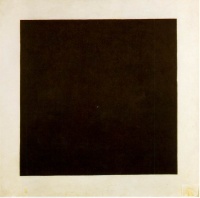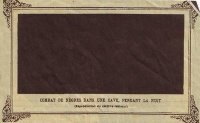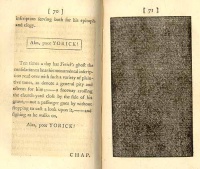Monochrome
From The Art and Popular Culture Encyclopedia
(Difference between revisions)
| Revision as of 11:52, 11 July 2007 WikiSysop (Talk | contribs) (→Monochromes in art) ← Previous diff |
Current revision Jahsonic (Talk | contribs) |
||
| Line 1: | Line 1: | ||
| + | [[Image:Black Square by Malevich.jpg|thumb|left|200px|''[[Black Square]]'' (1915) by Kazimir Malevich]] | ||
| + | {| class="toccolours" style="float: left; margin-left: 1em; margin-right: 2em; font-size: 85%; background:#c6dbf7; color:black; width:30em; max-width: 40%;" cellspacing="5" | ||
| + | | style="text-align: left;" | | ||
| + | "The result of my life is simply nothing, a mood, a [[monochrome|single color]]. My result is like the painting of the artist who was to paint a picture of the [[Israelites]] crossing the [[Red Sea]]. To this end, he painted the whole wall [[red]], explaining that the Israelites had already crossed over, and that the Egyptians were drowned."--''[[Either/Or]]'' (1843) by Søren Kierkegaard | ||
| + | |} | ||
| + | |||
| + | [[Image:Combat de nègres dans un tunnel.jpg|thumb|right|200px|''[[Negroes Fighting in a Tunnel at Night]]'' (1882) by Paul Bilhaud]] | ||
| + | [[Image:The black page in Tristram Shandy.jpg|thumb|right|200px|The [[black page]] in ''[[The Life and Opinions of Tristram Shandy, Gentleman]]'' (1759-1767)]] | ||
| {{Template}} | {{Template}} | ||
| '''Monochrome''' comes from the two [[Greek language|Greek]] words ''mono'' (μoνο, meaning "only" or "alone"), and ''chroma'' (χρωμα, meaning "color"). A '''monochromatic''' object has a single [[color]]. | '''Monochrome''' comes from the two [[Greek language|Greek]] words ''mono'' (μoνο, meaning "only" or "alone"), and ''chroma'' (χρωμα, meaning "color"). A '''monochromatic''' object has a single [[color]]. | ||
| + | ==See also== | ||
| + | *[[Duotone]] – the use of two ink colors in printing | ||
| + | *[[Halftone]] – the use of black and white in a pattern that is [[perception|perceived]] as shades of grey (may be extended also to color images) | ||
| + | *[[Polychrome]] – of multiple colors, the opposite of monochrome | ||
| + | *[[Monochromacy]] (color blindness) | ||
| + | *[[Selective color]] – use of monochrome and color selectively within an image | ||
| + | *[[Monochrome painting]] – monochromes in art | ||
| + | ==Examples outside of art== | ||
| + | *[[The black page in Tristram Shandy]] | ||
| + | *[[The black plate in Utriusque Cosmi Maioris ]] | ||
| + | ==See also== | ||
| + | :''[[monochrome painting]]'' | ||
| - | == Monochromes in art == | ||
| - | |||
| - | * [[Yves_Klein#Monochrome_works|Yves Klein]] | ||
| - | * [[Black-and-white]] | ||
| - | * [[Paul Bilhaud]] | ||
| - | * [[Black Square]] | ||
| - | * [[Color field]] | ||
| {{GFDL}} | {{GFDL}} | ||
Current revision

Black Square (1915) by Kazimir Malevich
|
"The result of my life is simply nothing, a mood, a single color. My result is like the painting of the artist who was to paint a picture of the Israelites crossing the Red Sea. To this end, he painted the whole wall red, explaining that the Israelites had already crossed over, and that the Egyptians were drowned."--Either/Or (1843) by Søren Kierkegaard |

Negroes Fighting in a Tunnel at Night (1882) by Paul Bilhaud
|
Related e |
|
Featured: |
Monochrome comes from the two Greek words mono (μoνο, meaning "only" or "alone"), and chroma (χρωμα, meaning "color"). A monochromatic object has a single color.
[edit]
See also
- Duotone – the use of two ink colors in printing
- Halftone – the use of black and white in a pattern that is perceived as shades of grey (may be extended also to color images)
- Polychrome – of multiple colors, the opposite of monochrome
- Monochromacy (color blindness)
- Selective color – use of monochrome and color selectively within an image
- Monochrome painting – monochromes in art
[edit]
Examples outside of art
[edit]
See also
Unless indicated otherwise, the text in this article is either based on Wikipedia article "Monochrome" or another language Wikipedia page thereof used under the terms of the GNU Free Documentation License; or on research by Jahsonic and friends. See Art and Popular Culture's copyright notice.


